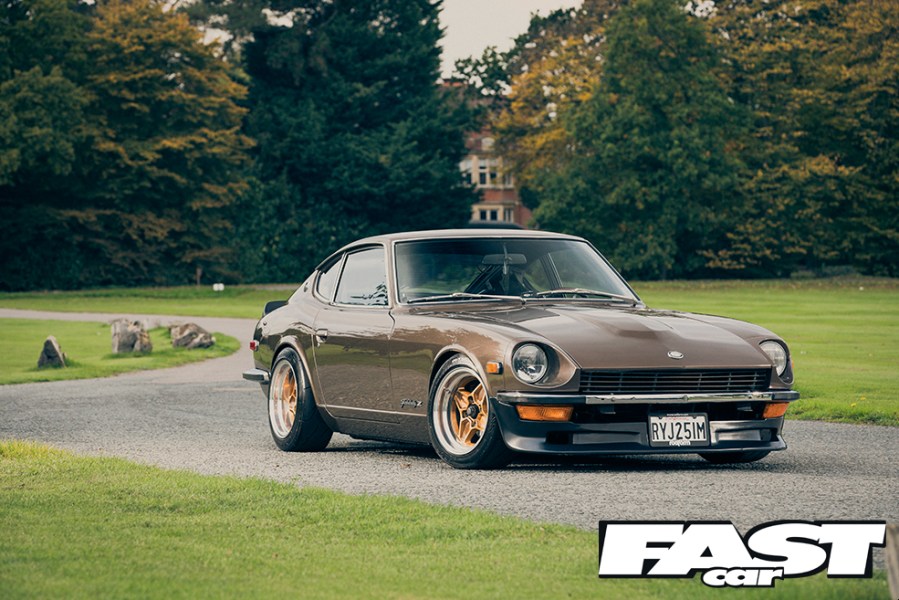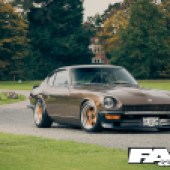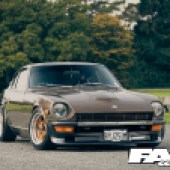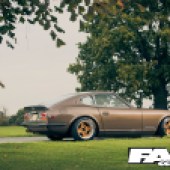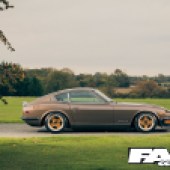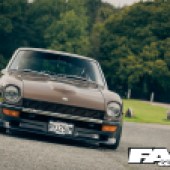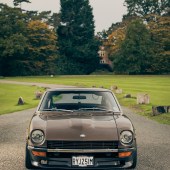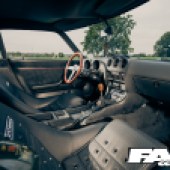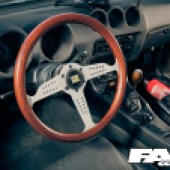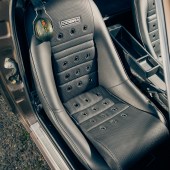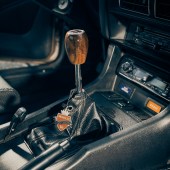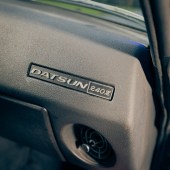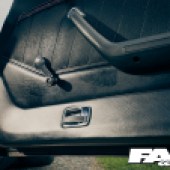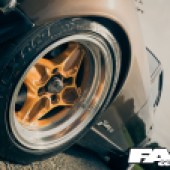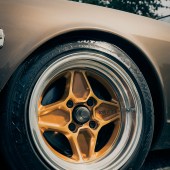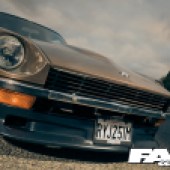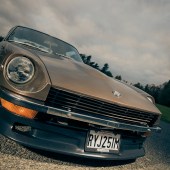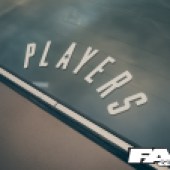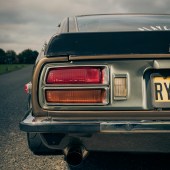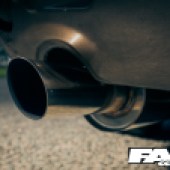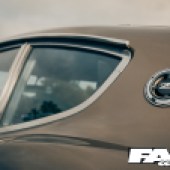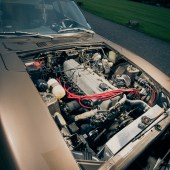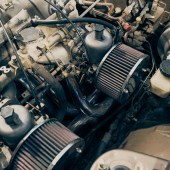We check out Jay McToldridge’s stunning tuned Datsun 240Z

The allure of the Z car is one of those perennial constants in the cosmos, like photosynthesis, gravity, and those fiddly little ketchup cups you get in McDonald’s; ever-present, ubiquitous, and inextricably interwoven into the very fabric of the universe itself. For many of you, the Datsun 240Z will need no introduction. But if you’re in the mood for a history lesson, here it is in a nutshell: in 1969, Datsun’s S30 series emerged onto the global motoring scene like some glorious butterfly from an intricately crafted Japanese chrysalis. It was so beautiful, so perfectly proportioned, that it slightly shifted the Earth from its axis, and countless onlookers swooned to the floor, overwhelmed by its majesty. (Probably.)

Sold as the Nissan Fairlady Z in Japan and the Datsun 240Z elsewhere, it’s no secret that the designers owed an unashamed stylistic debt to the Jaguar E-Type. The car’s long nose, squat cab and GT ethos were all very Jaguar, although the performance was thoroughly Japanese; it came with an eager twin-carbed straight-six, its 2.4-litres offering a raspy 150bhp-odd. There was all-independent suspension, rack-and-pinion steering, and 10.7” brake discs; it’d do 0-60mph in a flat eight seconds, and go on to 125mph.

To an early-seventies audience, this was a spec list to die for. The straight-six unit evolved for the 1974 model year into a longer-stroked 2.6, to create the logically-named 260Z. Increasingly stringent US emissions regulations ushered in a rapidly evolved variant the following year, the 280Z – which, as you’ve probably guessed, had a 2.8-litre motor. That’s what you’re looking at here.

It speaks volumes for the quality of the design that there’s still just as much to love about the Z today. While the march of technological progress means that the performance is now comparable to a perky hatchback, those hips don’t lie. Time has done nothing to dilute the sheer gorgeousness of the thing. The stats are only significant on paper, of course – certain newer and less exciting cars may be more powerful but they’re also heavier and more sanitised, and it’s all in the delivery – the venerable Datsun is a gruff, meaty, yet balletic thing, a constant source of joy.

But there’s always room for improvement. Even the Mona Lisa could do with smiling a bit more. And that’s where Jay McToldridge comes in.

Some of you may recognise the name; JayMac is the figurative and literal driving force behind the relentless Players Show colossus, collecting the finest modified metal from the UK and beyond into a series of top-flight shows every year, and it stands to reason that he’d know a thing or two about building badass cars. We featured his Mk1 Golf a few months back, and it immediately became our favourite Volkswagen. And that’s saying something. Retro Dubs are quite different to classic Datsuns though, aren’t they? So how did all this come about?

“Ah, I’ve always wanted one of these since I was a kid,” Jay grins. “Some people dream of 911s, but to me this has always been a better shape. And they’re rarer now!” Sound reasoning, we can totally get on board with that. Rarity is important, and you can’t put a price on style.

“I found the car advertised online,” he continues. “It was on sale with a dealer in Epping. He’d had it for over a year – it had belonged to a friend of his who’d moved to Malaysia so asked him to sell it. The pictures in the ad were awful, but we took a drive down to view it… and were amazed with what we found. It was so clean!”

This is thanks to the fact that the car had lived a pampered and easy life, and also that it was a Californian import; the one-owner car was all matching-numbers original and had covered just 50,000 miles in its carefree life in Newport Beach, Southern California. And you know what’s great about California? The weather’s better, so they don’t have to grit the roads in the winter.

Usually when you find original, unrestored 1970s Z cars they’re a bit crumbly – if they’ve lived in Japan, they’ve been rained on a lot; if they’ve been imported to the UK, they haven’t been rustproofed and have simply dissolved in the winter salt. But this car? “There was no rust in it anywhere, absolutely none at all,” breathes Jay with undisguised wonder. Lucky find, huh? A deal was done, and he collected the car a week later. A fulfilment of a lifelong dream.

Naturally, having got the pristine museum piece home, he did exactly what you or I would have done with this unmolested original: started modifying it to make it cooler.

“It was 100% stock when I bought it,” Jay explains. “The very first thing I did was to buy the BRE front lip, as the front end looks awful without it, and the next job was to do something about the ride height. I ordered a set of BC Racing coilovers with EMP Performance, but I got impatient and just couldn’t wait to get the thing lower, so we got it into the shop and cut the springs – just like we used to do in the ’90s!”

Before long the pukka BC units took the place of the hacked coils, and Jay threw on a timeless set of Watanabe wheels that he’d spotted for sale, at the same time getting on the blower to Nankang to order in a set of their sticky AR-1 cut slicks.

“To complement the coilovers, I also went mental on the Techno Toy Tuning website,” Jay laughs, “and basically ordered all of the billet suspension components they do – arms, struts, bushings, the lot. The guys there looked after me, and Carl brought it all over in his hand luggage.” (For the uninitiated, Carl Taylor is the other major player in the Players empire. The fact that he likes to hang out in the States makes this sort of international parts-hauling a little bit easier…)

One of the principle concerns with running an old motor-car is the ever-present worry of finding yourself parked on the hard shoulder in a cloud of steam, which hangs over every mile of motoring like the Sword of Damocles. Thankfully Jay was starting with a strong base, the car having always been looked after, but for the sake of belt-and-braces he tapped up Mishimoto for a custom setup to totally overhaul the Datsun’s cooling system – something that he says has made a huge difference. It’s also a useful base mod in terms of reliability, given that Jay’s ultimate treatment of the engine has seen its twin SU carbs replaced with triple Webers, the big-six barking through a custom exhaust to the tune of 200bhp at the wheels. Which is more than enough for mischief in a lightweight, rear-wheel-drive tearabout.

Those Watanabes were only a stop-gap as Jay’s always been a bit of a wheel perv, and the decision was made to work with Brian at Rotiform to create something unique and special for the Z: an old-style design with a fresh new twist, the GTB is a classic four-spoke with a lot more girth than you’d have found in the ’70s, rocking a gorgeous Tequila Sunset finish.

“Lastly came the seats,” says Jay. “I wanted an old-school Japanese look, and as usual Cobra came up trumps. And I really do use the car a lot now, considering its age; if it’s a nice day I’ll take it out and rag the life out of it! It’s probably the car that gets the most attention out of everything I’ve ever owned, which is saying a lot when you consider some of the ridiculous stuff we’ve done in the past. Most people love it, because you just don’t see these cars around any more.”

The fulfilment of a dream, then – a beautiful classic, tastefully updated and reengineered for mischief. Job done, on to the next one? “Oh no, I’ve got plans,” Jay laughs. “How does a Rebello 3.2 stroker engine running 340bhp sound?” Yep, sure, that sounds alright to us. The Datsun’s reawakening has been an unqualified success, and it’s turned into a real waking dream. Zed’s not dead, baby. Zed’s not dead.

TECH SPEC NISSAN 240Z
Styling:
BRE front splitter, BRE rear ducktail spoiler
Tuning:
2.8-litre L28 straight-six, triple Weber 40 carbs, custom equal-length manifold, full EMP 2.5” stainless steel exhaust system, Mishimoto radiator, 5-speed manual, 200bhp at wheels
Chassis:
8×15” ET0 and ET-15 Rotiform GTB wheels, 195/50 Nankang AR-1 cut slicks, BC Racing coilovers, Techno Toy Tuning billet lower front and rear control arms, Techno Toy Tuning billet TC rods, Techno Toy Tuning billet hubs
Interior:
Cobra RS seats, Nardi wood-rim steering wheel
Thanks:
“James at The Play Bay, the boys at John Danby Racing, Brian and Jason at Rotiform, Ben at Nankang, Dom at Snap-On, Tom at Meguiars, the boys at Forge Motorsport, Cobra Seats, Patrick at Mishimoto, the boys at Playhouse, Will and Kelv at Chelmsford Autos”.
Words Dan Bevis Photography Dan Pullen

